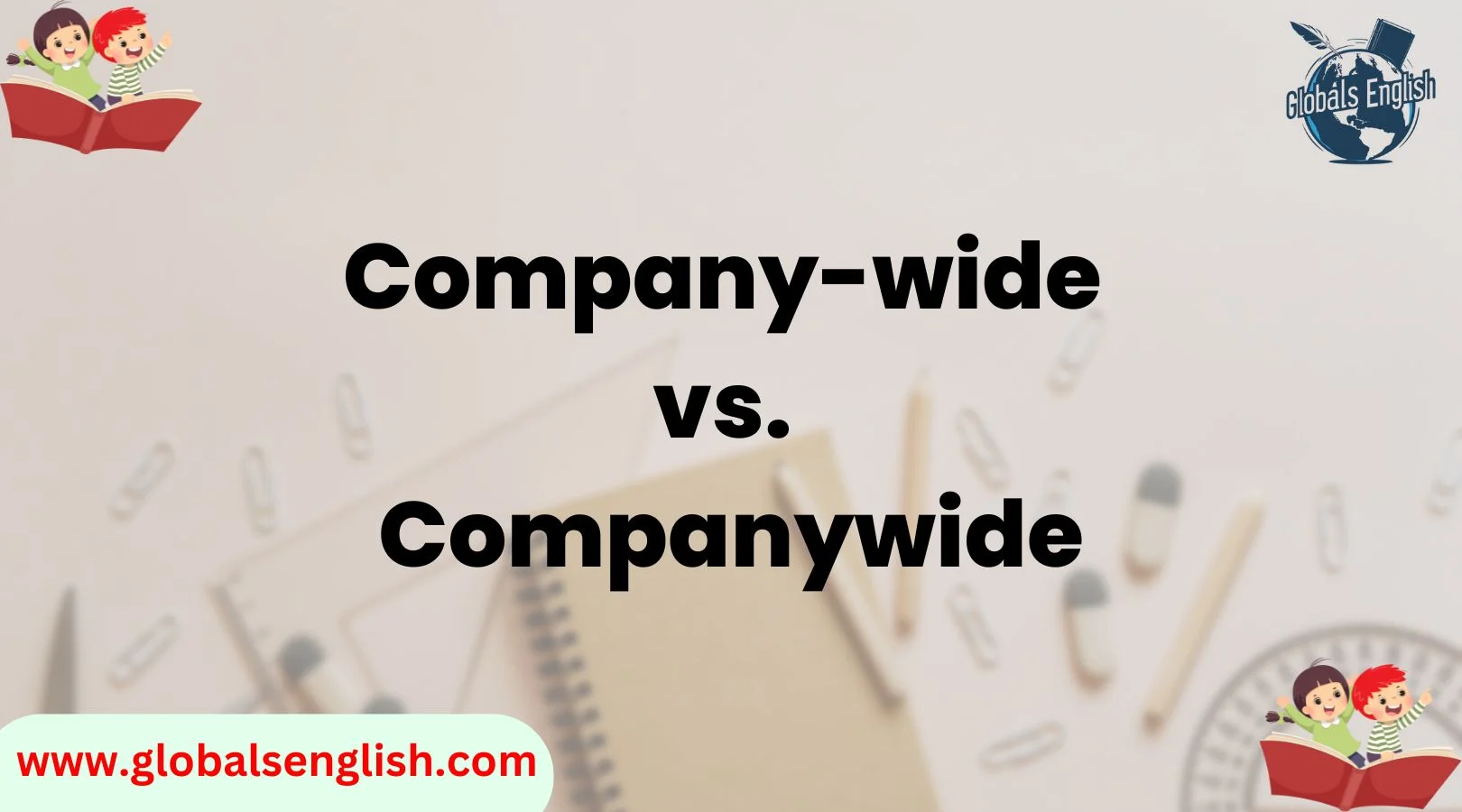When it comes to business writing, clarity and precision are paramount. The terms “company-wide” and “companywide” are often used interchangeably, but there are distinct differences in how these two words should be used.
Understanding whether you should opt for a hyphenated or non-hyphenated form isn’t just about grammar—it’s about ensuring that your communication is professional, clear, and trustworthy.
In this article, we’ll explore both terms in-depth, examining their definitions, history, correct usage, and impact on business communication. By the end, you’ll know exactly when to use “company-wide” vs. “companywide”, and how it can make a difference in your business writing.
Understanding the Basics: What Do “Company-wide” and “Companywide” Mean?
To start, it’s important to understand the fundamental meaning of these terms. At their core, both “company-wide” and “companywide” describe something that applies across an entire company. They indicate that a policy, decision, initiative, or even a change affects the entire organization.
- “Company-wide”: The hyphenated version is a compound adjective used to describe something that impacts the whole company. It modifies a noun that comes after it, ensuring clarity and preventing any confusion in communication.
- “Companywide”: The non-hyphenated version is simply a compound noun, used in a more general sense to refer to something that spans the entire company without the need for immediate clarification.
For example, if a company is rolling out a new software platform, you might say, “The new system is being introduced company-wide.” Alternatively, if you were referring to an initiative, you might say, “We need to implement this companywide.”
Understanding these distinctions is the first step in determining the proper usage of these terms.
The History Behind the Terms
Before we dive into the grammar rules and preferences of these two forms, let’s take a look at their historical development.
Origins of “Company-wide”
The hyphenated version, “company-wide”, has existed for a long time. Historically, the hyphen was used in compound adjectives to make the meaning of phrases more clear and understandable. Before the rise of digital writing, writers and editors paid close attention to grammar rules that dictated the use of hyphens in compound adjectives. Hyphenation was considered essential for clarifying the connection between two words, especially when they were being used to describe something specific, like “company-wide policies.”
How “Companywide” Emerged
As language has evolved, particularly in business contexts, the trend has shifted towards dropping the hyphen in many compound adjectives, including “company-wide.” This change reflects the broader trend of simplifying language and making it easier to read and write. Over time, “companywide” began appearing more frequently in corporate communications, and today, it’s accepted as a standard form in many style guides.
Which One Is Correct? Company-wide vs. Companywide
This is the million-dollar question. So, which form is correct? The truth is, both can be correct depending on the context and the guidelines you’re following. However, let’s break it down further with expert insights.
Grammar Experts’ Views
Most modern style guides, including Merriam-Webster, AP, and Oxford, lean towards using the non-hyphenated version, “companywide”. In fact, as language evolves, more compound adjectives are being written without hyphens, especially in contexts where clarity is not compromised.
- Merriam-Webster favors the single-word version, emphasizing that modern compound adjectives often drop the hyphen, particularly when they become familiar or widely used in English.
- The AP Style Guide, on the other hand, allows flexibility, though it does often favor the non-hyphenated form for terms that are well-established in business and other professional settings.
Standardization in Modern English
In general, language experts agree that companywide is now the more standardized version. The trend toward removing hyphens is a reflection of the evolving nature of English, especially in business contexts where speed and efficiency are key. However, it’s important to be consistent in your use of the term once you’ve chosen one version.
When to Use “Company-wide”
Even though “companywide” is widely used, there are still instances when the hyphenated version, “company-wide,” may be necessary or preferred.
Situations Requiring Hyphenation
“Company-wide” should be used when you are using it as a compound adjective that directly modifies a noun. This is important for maintaining grammatical correctness. A compound adjective is when two words work together to describe another word. The hyphen links the words together to show they are functioning as a single unit.
- Example: “The company-wide initiative was a success.”
- Example: “The company-wide training program is mandatory.”
In both examples, the hyphenated version ensures that the term is clearly modifying the noun that follows it, making it grammatically correct.
Common Mistakes to Avoid
One common mistake is using the hyphenated form when it’s unnecessary. For example, “The companywide initiative was a success” is perfectly acceptable and grammatically correct.
When to Use “Companywide”
Now that we understand when to use “company-wide,” let’s dive into when the non-hyphenated version, “companywide,” is appropriate.
When It’s Correct to Drop the Hyphen
In modern business writing, “companywide” is typically used when it’s functioning as a noun or when there is no need for immediate clarification with a following noun. Essentially, it’s the simplified, more streamlined version of the term.
- Example: “This change will be implemented companywide.”
- Example: “The new companywide strategy will be discussed at the meeting.”
In both examples, “companywide” is not directly modifying a noun. Instead, it stands alone as a single term that still conveys the same meaning without the need for hyphenation.
Impact of “Companywide” in Professional Contexts
The non-hyphenated version has become increasingly common in modern corporate communication, especially in internal memos, emails, and marketing materials. It gives the text a smoother, more contemporary feel, aligning with the trend towards simplified language in professional environments.
Common Mistakes in Writing: How to Avoid Them
While choosing between “company-wide” and “companywide” may seem trivial, incorrect usage can confuse your audience or make your writing appear unprofessional. Here are some common mistakes:
- Inconsistent Use: Switching between “company-wide” and “companywide” in the same document.
- Overuse of Hyphenation: Using “company-wide” when “companywide” would suffice.
- Misuse as a Noun: Writing “company-wide” when it functions as a noun.
Tips for Ensuring Consistency
To ensure that your writing is consistent and accurate:
- Create a Style Guide: Outline your preferences for using “companywide” vs. “company-wide” across all company documents.
- Use Editing Tools: Many online writing tools can help you identify inconsistencies in hyphenation.
- Proofread: Before sending out any communication, ensure you are using the correct term based on the context.
FAQs: Company-wide vs. Companywide
1. Which is correct: “company-wide” or “companywide”?
Both “company-wide” and “companywide” are correct, but the preferred form depends on the context. “Company-wide” is often used as a compound adjective (e.g., “a company-wide policy”), while “companywide” is a more modern, non-hyphenated alternative used in general contexts (e.g., “The changes apply companywide”).
2. Is “companywide” a real word?
Yes, “companywide” is recognized in dictionaries like Merriam-Webster and is commonly used in modern business writing. Over time, many compound words have lost their hyphens, and “companywide” follows this trend.
3. Should I use “companywide” in formal writing?
Yes, “companywide” is widely accepted in formal and corporate writing. However, some traditional style guides (like AP) may still recommend the hyphenated form. The key is to stay consistent throughout your writing.
4. Does “company-wide” mean the same thing as “companywide”?
Yes, both terms mean the same thing—something that applies to the entire company. The difference lies in spelling and style preferences rather than meaning.
5. Why do some people still use “company-wide” instead of “companywide”?
Some people use “company-wide” because older grammar rules favored hyphenation in compound adjectives. Additionally, certain style guides still recommend hyphenating compound modifiers before a noun.
Conclusion
In conclusion, while both “company-wide” and “companywide” are acceptable, the non-hyphenated form is increasingly preferred in modern business communication. As language evolves, simplicity and clarity take precedence, making “companywide” the more streamlined and professional choice in many contexts. However, there are still situations where “company-wide” remains appropriate. The key is to stay consistent and choose the form that best suits your corporate communication and brand identity.

Mia Rose are the minds behind Globals English, a platform dedicated to making English learning simple, engaging, and effective. With a shared passion for education and communication, they bring years of experience in language teaching and curriculum development.
